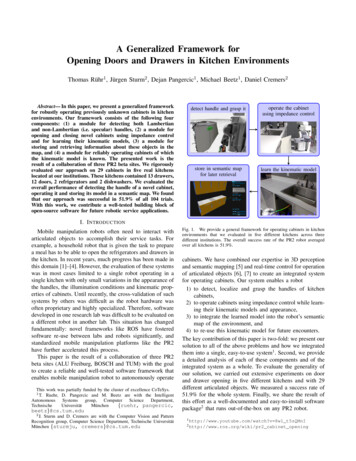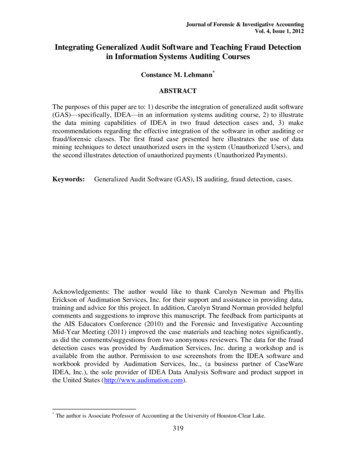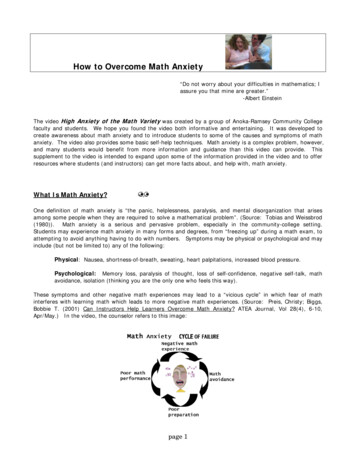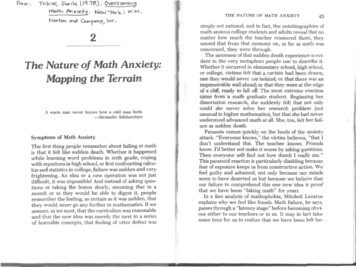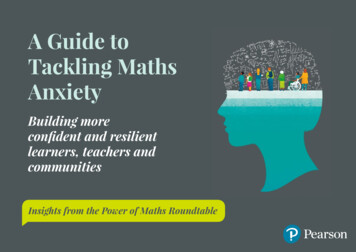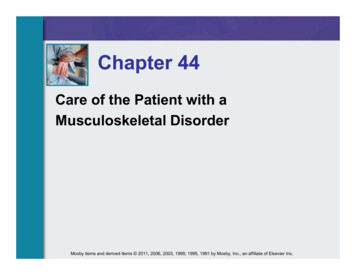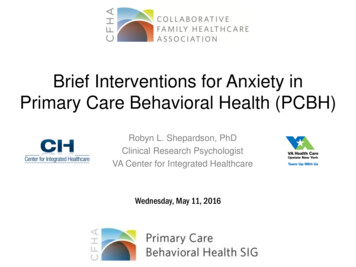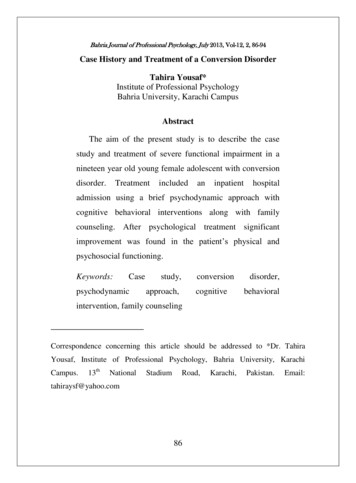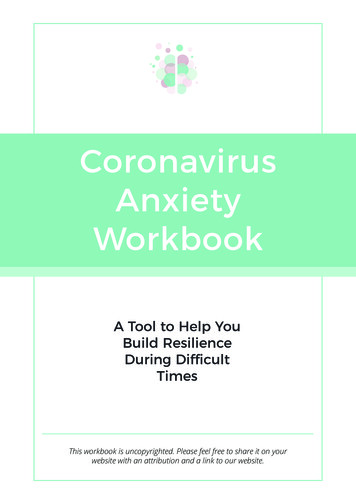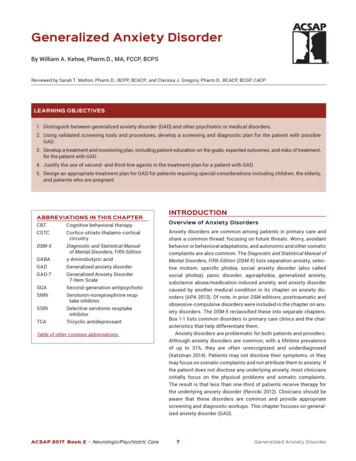
Transcription
Generalized Anxiety DisorderBy William A. Kehoe, Pharm.D., MA, FCCP, BCPSReviewed by Sarah T. Melton, Pharm.D., BCPP, BCACP; and Clarissa J. Gregory, Pharm.D., BCACP, BCGP, CACPLEARNING OBJECTIVES1. Distinguish between generalized anxiety disorder (GAD) and other psychiatric or medical disorders.2. Using validated screening tools and procedures, develop a screening and diagnostic plan for the patient with possibleGAD.3. Develop a treatment and monitoring plan, including patient education on the goals, expected outcomes, and risks of treatment,for the patient with GAD.4. Justify the use of second- and third-line agents in the treatment plan for a patient with GAD.5. Design an appropriate treatment plan for GAD for patients requiring special considerations including children, the elderly,and patients who are pregnant.ABBREVIATIONS IN THIS tive behavioral agnostic and Statistical Manualof Mental Disorders, Fifth Editionγ-Aminobutyric acidGeneralized anxiety disorderGeneralized Anxiety Disorder7-Item ScaleSecond-generation antipsychoticSerotonin-norepinephrine reuptake inhibitorSelective serotonin reuptakeinhibitorTricyclic antidepressantTable of other common abbreviations.ACSAP 2017 Book 2 Neurologic/Psychiatric CareINTRODUCTIONOverview of Anxiety DisordersAnxiety disorders are common among patients in primary care andshare a common thread: focusing on future threats. Worry, avoidantbehavior or behavioral adaptations, and autonomic and other somaticcomplaints are also common. The Diagnostic and Statistical Manual ofMental Disorders, Fifth Edition (DSM-5) lists separation anxiety, selective mutism, specific phobia, social anxiety disorder (also calledsocial phobia), panic disorder, agoraphobia, generalized anxiety,substance abuse/medication-induced anxiety, and anxiety disordercaused by another medical condition in its chapter on anxiety disorders (APA 2013). Of note, in prior DSM editions, posttraumatic andobsessive-compulsive disorders were included in the chapter on anxiety disorders. The DSM-5 reclassified these into separate chapters.Box 1-1 lists common disorders in primary care clinics and the characteristics that help differentiate them.Anxiety disorders are problematic for both patients and providers.Although anxiety disorders are common, with a lifetime prevalenceof up to 31%, they are often unrecognized and underdiagnosed(Katzman 2014). Patients may not disclose their symptoms, or theymay focus on somatic complaints and not attribute them to anxiety. Ifthe patient does not disclose any underlying anxiety, most cliniciansinitially focus on the physical problems and somatic complaints.The result is that less than one-third of patients receive therapy forthe underlying anxiety disorder (Revicki 2012). Clinicians should beaware that these disorders are common and provide appropriatescreening and diagnostic workups. This chapter focuses on generalized anxiety disorder (GAD).7Generalized Anxiety Disorder
Definitions and Diagnostic Criteria for GADBox 1-1. Characteristics of SelectedAnxiety Disorders in the DSM-5The characteristics of GAD as described in the DSM-5 areshown in Table 1-1. The issues assessed on two commonscreening instruments (i.e., the Generalized Anxiety Disorder7-Item scale (GAD-7) and the Penn State Worry Questionnaire)are shown beside these criteria for reference. A score greaterthan 10 on the GAD-7 suggests a diagnosis of GAD. The scoreon the Penn State Worry Questionnaire designates an acuity level of worry as low (16–39), moderate (40–59), or high(60–80). These screening tools are readily available and easyto use in the ambulatory setting.For the main features of GAD, see Table 1-1. Anxiety andworry occur as a normal part of life. What distinguishes pathologic anxiety from normal worry is the severity of anxiety,difficulty in controlling it, and significant social and functionalimpairment it causes. Anxiety and worry may focus on potential future events, but they are out of proportion to what mightreally happen. Of interest, although excessive worry is a central feature of GAD, it appears to be a psychological defensemechanism to allow some sense of control over what mighthappen if the feared event occurs (Behar 2009). Excessiveworry can become a learned cycle of thinking that becomes acognitive pattern, leading to impairment.Generalized Anxiety DisorderPsychological symptoms: Excessive anxiety,uncontrolled worry, feeling on edge, poor concentration,restlessness, irritability, impaired social or occupationalfunctioningPhysical symptoms: Fatigue, muscle tension, difficultysleepingPanic DisorderRecurrent panic attacks manifested by these symptoms:Psychological: Fear of losing control or dying, fear of inabilityto escape from fearful situationsPhysical symptoms: Chest pain or discomfort, dizziness,shortness of breath, tachycardia, tremor, nausea, palpitations,sweatingAgoraphobiaAgoraphobia may result from repeated panic attacksPsychological symptoms: Fear, anxiety, and avoidance in twoor more of the following situations: public transportation,open spaces, enclosed places, standing in line or being in acrowd, being away from home aloneSocial Anxiety DisorderPsychological symptoms: Fear of being embarrassed,humiliated, or evaluated by others; fear of situations such asspeaking, eating, or interacting in a group of people or withauthority figures; public speaking; talking with strangersPhysical symptoms: GI upset – diarrhea; sweating, flushing,tachycardia, tremorBASELINE KNOWLEDGE STATEMENTSReaders of this chapter are presumed to be familiarwith the following: Information from the American Psychiatric Association. Diagnosticand Statistical Manual of Mental Disorders, Fifth Edition (DSM-5).Clinical pharmacology of the antidepressants,anxiolytics, benzodiazepines, anticonvulsants,and second-generation antipsychotics discussedin this chapterRecognition of signs and symptoms of anxietySomatic features of GAD are common, which can be whypatients seek medical care. Complaints such as muscleaches and tension, headaches, backaches, GI issues, problems with sleep, and fatigue are common. Anxiety disordersare also associated with several medical illnesses such asthyroid disease and respiratory disease. This associationleads to increased disability and decreased quality of life(Saren 2006). One study found that patients with anxietydisorders and depression had higher rates of somatic disease such as asthma, heart disease, back problems, ulcer,migraines, and eyesight problems (Niles 2015). In addition,a 1-SD increase in the severity of the anxiety and depressive symptoms was associated with a 15% increase in thenumber of medical conditions. To put this in perspective,1 SD in BMI is associated with a 12% increase in medicalconditions (Niles 2015). Thus, anxiety disorders are associated with physical health risks similar to being overweight.Therefore, patients with somatic complaints for which noorganic causes can be identified should be assessed for ananxiety disorder.Basic patient educational points for the medications described in this chapterTable of common laboratory reference values.ADDITIONAL READINGSThe following free resources have additional background information on this topic: National Institute for Health and Care Excellence(NICE). Clinical Guideline: Generalized AnxietyDisorder and Panic Disorder in Adults.Canadian Medical Association. Clinical PracticeGuidelines for the Management of Anxiety,Posttraumatic Stress, and Obsessive-CompulsiveDisorders.Harvard Medical School, Department of Psychiatry,South Shore Program. PsychopharmacologyAlgorithm Project.ACSAP 2017 Book 2 Neurologic/Psychiatric Care8Generalized Anxiety Disorder
Table 1-1. DSM-5 Criteria for GAD and Screening QuestionsCharacteristics of GAD accordingto the DSM-5Excessive worry and anxiety occur most of the time for at least 6 moThe worry is difficult to controlThe anxiety and worry are associated with at least three of the following core symptoms: Feeling restless, keyed up, or on edgeFatiguing easilyDifficulty concentrating or the mind going blankIrritabilityIncreased muscle tensionDifficulty falling asleep, staying asleep, or restlessnessThe symptoms cause significant distress or impairmentThe problems are not attributable to a physical ailmentThe problems are not explained by other mental disordersFactors screened for by the GAD-7Feeling nervous, anxious, or on edgeNot being able to stop or control worryingWorrying too much about different thingsTrouble relaxingBeing so restless it is hard to sit stillBecoming easily annoyed or irritatedFeeling as if something awful might happenFactors screened for by the PennState Worry QuestionnaireIf I do not have enough time to do everything, I do not worry about itMy worries overwhelm meI do not tend to worry about thingsMany situations make me worryI know I should not worry about things, but I just cannot help itWhen I am under pressure, I worry a lotI am always worrying about somethingI find it easy to dismiss worrisome thoughtsAs soon as I finish one task, I start to worry about everything else I have to doI never worry about anythingWhen there is nothing more I can do about a concern, I do not worry about it anymoreI have been a worrier all my lifeI notice that I have been worrying about thingsOnce I start worrying, I cannot stopI worry all the timeGAD generalized anxiety disorder.Information from the American Psychiatric Association. Diagnostic and Statistical Manual of Mental Disorders, Fifth Edition(DSM-5).IMPACT OF GADhave an anxiety disorder to ensure that all issues are identified (Spitzer 2006).In the same study, 41% of the patients were not receivingtreatment. Of those treated, 42% were receiving medicationsalone, 4% were receiving psychological therapy, and 13% werereceiving both. These data show that anxiety disorders areoften unrecognized and untreated. In addition, scores onthe Medical Outcomes Study Short Form-20 functional status for patients with GAD showed significant impairment onall scales (mental health, social function, role function, general health, bodily pain, physical function). Clearly, anxietyFunctional Impact and Quality of LifeComorbidity is common among anxiety disorders. A study ofprimary care patients assessed the impact of several anxietydisorders, with one of them being GAD. The study included965 patients who completed the GAD-7 questionnaire.Generalized anxiety disorder was present in 7.6% of patients.Of importance, one-third of the patients with one anxietydisorder had at least one other; thus, comorbidity amongpatients is common. This finding underscores the need forcareful and complete assessments of patients thought toACSAP 2017 Book 2 Neurologic/Psychiatric Care9Generalized Anxiety Disorder
disorders like GAD significantly affect patient health andreduce quality of life.Other studies have also documented the impact of GAD. Arecent systematic review studied the effect of GAD on humanistic and economic outcomes among patients in the UnitedStates and Europe (Revicki 2012). A total of 144 papers metthe study inclusion criteria of evaluating patients with GADand reporting humanistic and economic outcomes. Whenhealth-related quality-of-life outcomes were evaluated, psychosocial functioning, role function, work productivity, anddisability days were significantly impaired. These findingsare similar to those of prior studies. One study found thatall SF-36 (36-item short-form health survey) subscales wereaffected for patients with GAD compared with patients without GAD, indicating significant impairments (Wetherell 2013).Patients with GAD also report more occupational impairment and missed days of work; they tend to use more healthcare resources and are 1.6 times more likely to see a primarycare provider more than four times per year. However, only19.8% of these patients are receiving pharmacotherapy forthe symptoms (Wittchen 2001). This again shows that GADcauses significant impairments but is often untreated.Fear and anxiety share many features and can be difficultto differentiate. One helpful way to conceptualize them is tothink of fear as a response to an immediate threat, whereasanxiety is usually an anticipatory response to perceivedor real future events (APA 2013). Worry is the cognitiveresponse to fear and anxiety. Worry involves negative mentalimages and emotions. Although some might think of worryas a cause of anxiety, worry appears to be an attempt at selfprotection from the more catastrophic consequences of thefeared object (Behar 2009). The individual may falsely viewworry as an effective coping mechanism. Worry, however,becomes pathologic when it is excessive and is a core feature of GAD.Acquiring fears is a normal part of development. Fears candevelop in a classical conditioning paradigm. Aversive occurrences in life can be viewed as unconditioned stimuli. Whenpaired with a neutral stimulus, these eventually become aconditioned stimulus that can elicit fear (CR). Under normalcircumstances, this process is adaptive because it helpsthe patient avoid potentially harmful things. If other neutralstimuli become feared (conditioned stimulus and CR), the person’s fears become more generalized. This paradigm involvescircuits in the amygdala, hypothalamus, and prefrontal cortex. Investigators have suggested that patients with anxietyhave exaggerated responses to danger cues and a reducedresponse to safety cues that would mitigate the fear response(Lissek 2005). Serotonin appears to be involved in modulating responsiveness to threatening cues. One study found thatcitalopram decreased amygdala responses to threat presentations, suggesting this as one way that selective serotoninreuptake inhibitors (SSRIs) affect anxiety (Harmer 2006).Because fear acquisition is a learning process, psychologicapproaches such as CBT may also affect fear conditioni
screening instruments (i.e., the Generalized Anxiety Disorder 7-Item scale (GAD-7) and the Penn State Worry Questionnaire) are shown beside these criteria for reference. A score greater than 10 on the GAD-7 suggests a diagnosis of GAD. The score on the Penn State Worry Questionnaire designates an acu-
